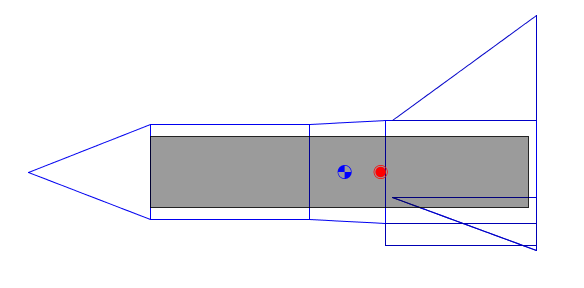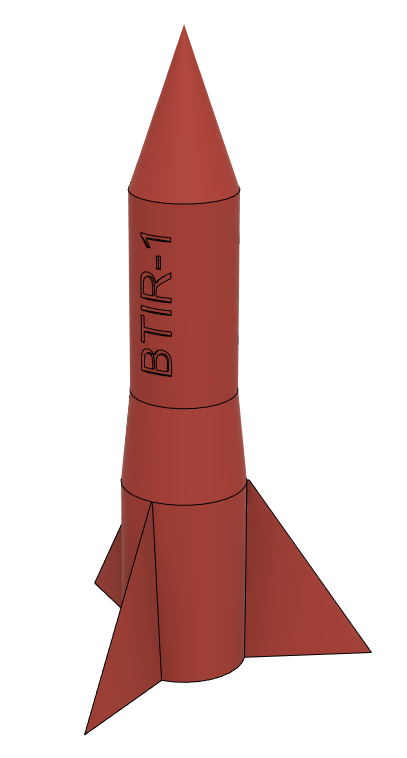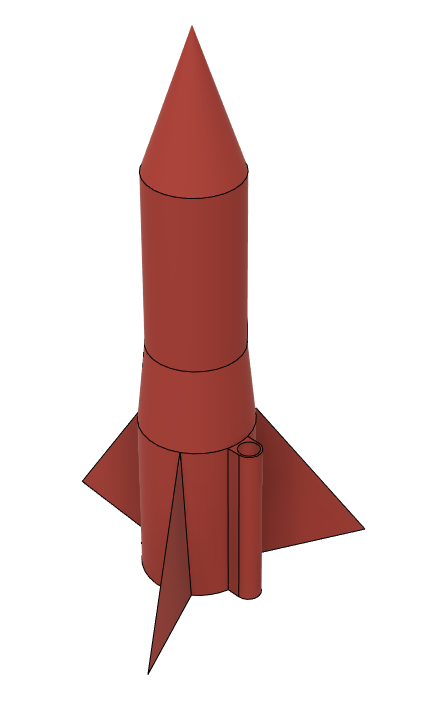Introduction & Concept
After a bout of boredom powered inspiration, I have conceived of a ‘stopgap’ rocket to tide me over until proper launches can be conducted
Introducing: the BTIR, or Ballistic Trajectory and Impact Rocket
(Note the partly hollow nosecone, this is to save weight)
//Pictures of print to be inserted later
The basic idea is: “Why do I need a parachute anyway”, which simplifies matters considerably, since the (soft and controlled) landing is the hard part
Consisting simply of a 3d printed aerodynamic ‘shell’ which houses a single RC2 Polymer Cased Rocket Engine, intended to provide stability during launch and ascent, and minimize drag
Its revolutionary development, as stated above, is the omission of a parachute
This has the advantage of greatly reducing weight, resulting in increased height, and also removes most complex systems such as altitude detection and parachute ejection, resulting in a more reliable rocket
It also has the downside of making the rocket not able to slow down
This might sound a bit stupid, and trust me, it is, but I feel the simplicity outweighs the downsides
Its shell can be produced by a 3D printer in 3 hours, during which the author could easily produce a single RC2 engine in parallel, and since the motor is single use anyway and PLA is cheap, its fully expendable, meaning it does not even have to land in one piece
It still has value as a craft too, for a number of reasons, such as:
- Morale boost from finally employing casing 2.0 engines in a practical design, after a year of development
- Lessons in general and aerodynamic design
- Real world experience with planning, coordinating and executing a launch
- Altitude measurement trough triangulation
- Experience in Rocket recovery
- Data on the effect of a parachute ejection failure
- And more!
This all seems very reasonable to me for something that can be done in such a short time at little cost
The design for the shell was made over the course of a evening, and subsequently printed, with a launch pad being built while waiting on the print
The shell is red like communism to facilitate easier recovery due to increased visibility and contrast, with red specifically being chosen because its the only applicable color I have a spool of
The launch pad itself simply consists of a small length of wood, the metal underside of a old microphone, and a collapsible launch rod
The metal allows the wood to remain untarnished from the exhaust, with the rod and wire-brace keeping the rocket in a predictable position until liftoff
//pictures will be added later
due to the launch pad being easily assembled / disassembled, and the rather small size of the rocket, I figure they should both easily fit into a standard ammo can for storage and transportation
Side note: the collapsible launching rod used in the construction of the launch pad and essential to this project, was generously donated to me together with 3 full model rockets and various other supplies by a ex-experimenter and friend of mine, thanks a lot man!
Problems & Solutions
Now for the main problem with this concept: its gonna come down and its gonna come down hard
On the one hand, it has a dry mass in the 30 gram range, so its not exactly heavy
on the other hand its aerodynamic and high enough it should still be able to pick up quite some speed
And its unguided, so there is no telling where its gonna end up
So great care must be taken to prevent injury or disruption
I propose that it is launched from a large, unoccupied field (preferably with permission), and the crew wears helmets
Now I know this sounds silly, and again, it is, but the main danger is it falling onto someone’s head, injuring them
Helmets should prevent this unlikely incident from being harmful
Depending on preliminary test results helmets might also be found to be overkill, and not necessary for safe operation provided distance can be kept
(on further consideration helmets seem a bit silly, so distance and situational awareness are to be used instead)
Another prospective problem would be ‘Nozzle shift’, as observed in the test of R-10
From that article:
” In the second video you can see the thrust being directed to the right partway trough, before returning shortly thereafter
I can offer 2 potential explanations
– Temporary clog on one side
– Internal nozzle ring shifting during firing
I could imagine the effect this would have during flight could be catastrophic, so it is of note. “
Is of note indeed
If I had to guess its the inner, small diameter washer moving about the place, since smooth metal on metal provides little friction and the forces involved sure are enough
This could possibly be prevented by a 3d printed ring to occupy the space it would otherwise move to
Preventing this is important because if the thrust is redirected, so is the rocket, which could lead to catastrophic and unpredictable results
If and when the first launch will take place is based on a variety of factors, such as (but not limited to) material availability, safety concerns, launch site considerations and crew constraints
But I do fully intend to fly this thing if at all possible, provided its done safely and properly
To gain launch stability data before a actual launch, a pressure based potato cannon could be developed (if funding allows it) to propel a test version high into the air to observe its descent and characterize its terminal velocity
This system could also be employed to test parachute ejection systems without having to rely on a rocket motor, decreasing complexity and cost of testing
Possible iterations could also include:
- Redesigned Fins
- Smaller launching lug
- Shape Redesign
- Screwed on nosecone with small payload
- Larger version with Parachute
Calculations & Estimations
Using data from R-10 as a baseline, which was calculated using Impulse calculator 2000, I can make a educated guesstimation with Altitude Estimator

And after a rough recreation in OpenRocket, using Impulse Calculator 2500‘s new RASP export function to recreate R-10, I got simulation results very similar to what is estimated (allowing for a margin of error in both programs of course)



| Velocity off rod | Apogee | Max. velocity | Max. acceleration | Time to apogee | Flight time | Ground hit velocity |
| 2.47 m/s | 135 m | 48.6 m/s | 59 m/s2 | 6.07 s | 12 s | 37.8 m/s |
A hundred meters would be amazing to achieve, but since the rocket has no altimeter it would have to be deduced trough triangulation, requiring increased manpower and additional equipment
As such, it might be worth it to fly the first launch ‘Blind’ to test the waters and prove feasibility
The circular error probability is also unknown, increasing the search range and danger zone
All of this must be accounted for to ensure absolute safety for all involved
If further testing is conducted or the program is cancelled this will be appended here





Epik